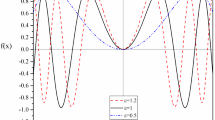Abstract
Power flow is an important measure in vibratory energy propagation path analysis. For one-dimensional structural elements, i.e., bars or beams, power flow is obtained using a relationship involving degrees of freedom (DOF) of interest, and the respective internal forces. Several published works on vibration analysis involving the finite element method (FEM) and its optimization describe measures of interest only in terms of DOF (such as displacement and mean square velocity). However, in scenarios involving the coupling of different structures, these measures are inadequate. For example, minimizing only dynamical displacements at specific points in a structure could result in the internal forces at those points becoming unacceptably large. In such cases, minimizing power flow is preferable over minimizing displacements. In this manuscript, using FEM and a gradient-based optimization method, the authors propose a technique to evaluate and optimize vibratory power flow specifically in cases involving beam–plate coupling. The total power flow at the connection point is defined as a function of the global displacement vector, and it is evaluated for a given frequency by harmonic analysis; the relevant sensitivities are obtained using elementary matrices and the adjoint method. Geometrical parameters of the beam are used as design variables. A description of the methodology and two examples of its application to beam–plate structures are presented.





















Similar content being viewed by others
References
Bendsøe MP, Sigmund O (2004) Topology optimization: theory, methods and applications. Springer, New York
Cho S, Park CY, Park YH, Hong SY (2006) Topology design optimization of structures at high frequencies using power flow analysis. J Sound Vib 298(12):206–220
Cieślik J (2004) Vibration energy flow in rectangular plates. J Theor Appl Mech 42:195–212
Diaz A, Haddow A, Ma L (2005) Design of band-gap grid structures. Struct Multidiscip Optim 29(6):418–431
Du J, Olhoff N (2007) Minimization of sound radiation from vibrating bi-material structures using topology optimization. Struct Multidiscip Optim 33(4–5):305–321
Gavric L, Pavic G (1993) A finite element method for computation of structural intensity by the normal mode approach. J Sound Vib 164(1):29–43
Jensen JS, Pedersen N (2005) Sensitivity analysis and topology optimization in structural dynamics. DCAMM Report
Jensen JS, Sigmund O (2003) Systematic design of phononic bandgap materials and structures by topology optimization. Philos Trans R Soc Lond Ser A Math Phys Eng Sci 361(1806):1001–1019
Jensen JS, Sigmund O (2005) Topology optimization of photonic crystal structures: a high-bandwidth low-loss T-junction waveguide. J Opt Soc Am B 22(6):1191–1198
Kim NH, Dong J, Choi KK (2004) Energy flow analysis and design sensitivity of structural problems at high frequencies. J Sound Vib 269(12):213–250
Li K, Li S, Zhao D (2010) Investigation on vibration energy flow characteristics in coupled plates by visualization techinques. J Mar Sci Technol 18(6):907–914
Liu L, Hussein MI (2011) Wave motion in periodic flexural beams and characterization of the transition between bragg scattering and local resonance. ASME. J Appl Mech 79(1):011003-1–011003-17. doi:10.1115/1.4004592
Martins P, Lenzi A (2015) Vibrational power flow analysis to hermetic compressor housing through a discharge tube made of polymeric material. In: Proceedings of the XVII international symposium on dynamic problems of mechanics, Natal
Mead D (1999) Passive vibration control. Wiley, New York
Niu B, Olhoff N (2014) Minimization of vibration power transmission from rotating machinery to a flexible supporting plate. Int J Struct Stab Dyn 14(3):1350068-1–1350068-28
Olhoff N, Du J (2009) On topological design optimization of structures against vibration and noise emission. In: Sandberg G, Ohayon R (eds) Computational aspects of structural acoustics and vibration, CISM international centre for mechanical sciences, vol 505. Springer, Vienna, pp 217–276
Przemieniecki J (1985) Theory of matrix structural analysis. Dover, New York
Silva OM, Guesser TM, Fiorentin TA, Lenzi A (2015) Shape optimization of compressor supporting plate based on vibration modes. Noise Control Eng J 63(1):49–58
Sorokin S, Nielsen J, Olhoff N (2001a) Analysis and optimization of energy flows in structures composed of beam elements—part II: examples and discussion. Struct Multidiscip Optim 22(1):12–23
Sorokin S, Nielsen J, Olhoff N (2001b) Analysis and optimization of energy flows in structures composed of beam elements—part I: problem formulation and solution technique. Struct Multidiscip Optim 22(1):3–11
Sorokin S, Olhoff N, Ershova O (2008) Analysis of the energy transmission in spatial piping systems with heavy internal fluid loading. J Sound Vib 310(45):1141–1166
Svanberg K (1987) The method of moving asymptotesa new method for structural optimization. Int J Numer Methods Eng 24(2):359–373
Weisser T, Foltte E, Bouhaddi N, Gonidou LO (2015) A power flow mode approach dedicated to structural interface dynamic characterization. J Sound Vib 334:202–218
Xing JT, Price WG (1999) A powerflow analysis based on continuum dynamics. Proc R Soc Lond Ser A Math Phys Eng Sci 455(1982):401–436
Yang X, Li Y (2013) Topology optimization to minimize the dynamic compliance of a bi-material plate in a thermal environment. Struct Multidiscip Optim 47(3):399–408
Zhang X, Kang Z, Li M (2014) Topology optimization of electrode coverage of piezoelectric thin-walled structures with cgvf control for minimizing sound radiation. Struct Multidiscip Optim 50(5):799–814
Acknowledgments
This work was supported by CAPES (Brazil) and IDMEC, Polo IST (Portugal). The authors are grateful to Prof. Krister Svanberg from Royal Institute of Technology, Stockholm, for providing his Matlab version of MMA, and to Prof. Luiz Augusto Saeger from Federal University of Santa Catarina, Brazil, for his valuable support on mathematical issues.
Author information
Authors and Affiliations
Corresponding author
Additional information
Technical Editor: Fernando Alves Rochinha.
Rights and permissions
About this article
Cite this article
Silva, O.M., Neves, M.M., Jordan, R. et al. An FEM-based method to evaluate and optimize vibration power flow through a beam-to-plate connection. J Braz. Soc. Mech. Sci. Eng. 39, 413–426 (2017). https://doi.org/10.1007/s40430-015-0360-2
Received:
Accepted:
Published:
Issue Date:
DOI: https://doi.org/10.1007/s40430-015-0360-2




